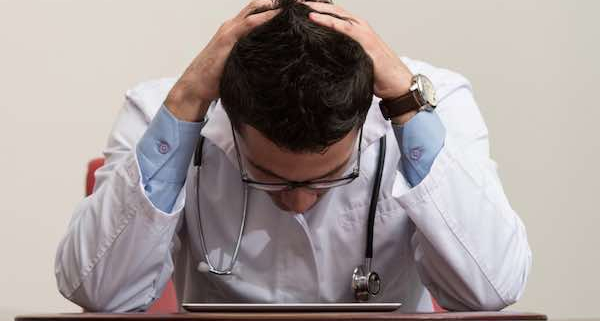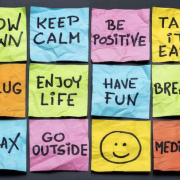Prevention: the Key to Banishing Physician Burnout
Given the long hours, the emotionally exhausting work, and the demands of seeing more patients in less time than ever, it’s no surprise that physician burnout is on the rise in the U.S. According to recent research, two-thirds of fully trained doctors currently experience symptoms of burnout, including emotional and physical exhaustion, anxiety, and depression.
Medical school students are feeling the burn too. Today, nearly half of the nation’s med school students screen positive for signs of depression, according Michael Kavan, Ph.D., Associate Dean for Student Affairs at Creighton University School of Medicine in Omaha, Nebraska. Says Dr. Kavan, who also teaches Family Medicine and Psychiatry at Creighton, balance and wellness training are the keys to abolishing physician burnout. And the time to learn them is med school. We interview Dr. Kavan below.
A Nationwide Epidemic
PhysEmp: It’s clear we have something of a physician-burnout epidemic on our hands. Why do you think this is happening?
Dr. Kavan: There’s a lot of stress associated with the profession, and right now there are a lot of changes taking place in healthcare. This uncertainty, combined with the increased pressure to see more patients more quickly contributes to many physicians feeling frustrated and a little disillusioned. In addition, physicians are frustrated by paperwork, or even electronic health records, insurance companies, and other factors that make working closely with patients hard. I think most physicians go into the profession to care for patients, and in some ways, that’s becoming more difficult.
The Signs & Symptoms of Physician Burnout
PhysEmp: What are some of the signs and symptoms of physician burnout?
Dr. Kavan: When we work with our medical students at Creighton, we help them identify three main issues related to burnout. One: when physicians feel emotionally drained or exhausted by what they do rather than being energized by their contact with patients. Two: there’s also a sense of depersonalization that occurs. Physicians can develop negative feelings or cynical attitudes towards the patients they’re seeing. The third and last component of physician burnout is a tendency to lack a sense of personal accomplishment. They judge their own work negatively and don’t feel they’re having the impact they’d like to. All of these factors are characteristic of burnout.
PhysEmp: Along with those factors, you’re seeing symptoms like anxiety, insomnia, depression and so on, correct?
Dr. Kavan: Yes. A lot of those do go hand in hand—not just in physicians, but in medical students. If you look at surveys, you’ll see a high rate of burnout: around 50 percent of students across the nation report burnout and 46.5 percent screen positive for symptoms of depression. Looking at these figures more closely, we see that on average 13-25% of medical students across the country report being clinically depressed, which is significant.
The Impact on Patient Care
PhysEmp: That’s huge. It’s alarming to think of physicians experiencing this, and it’s alarming to think how that impacts patient care. Would you say that physician burnout has always been an issue for students and physicians?
Dr. Kavan: Maybe to some extent, but we know that it has become an increasing problem over the past 10-plus years, and it’s something that’s been talked about much more recently among medical students, residents, and physicians. We’re more aware of it now. And we’re taking steps to address it, because it is impacting not only our doctors’ quality of life but also patient care.
PhysEmp: In your opinion, how is it impacting patient care?
Dr. Kavan: Medical students, residents, and physicians who are burned out and distressed probably aren’t performing at their best under these circumstances. If you’re depressed, you may not be able to concentrate as well, and depression certainly can impact motivation. A physician who is burned out is certainly at risk for providing a lower quality of care to his or her patients.
Effective Strategies for Eradicating Physician Burnout
PhysEmp: As a professor, do you have strategies that you offer to your students to help them recognize symptoms and cope with burnout?
Dr. Kavan: Absolutely. There are a few key things. One: helping students to recognize burnout in themselves and others. Two: helping them to manage it when it does happen. Three: what’s really important is making sure the institution or medical school itself has strategies in place to ensure it’s an environment that’s conducive to wellness as opposed to burnout and depression.
At Creighton, we have a very robust wellness program for our medical students. Beginning with our first-year orientation we provide presentations on student wellness issues, including how to recognize it and, more importantly, what they can do to prevent burnout, depression, and undue stress.
We also have a mandatory Physician Lifestyle Management course that every one of our first-, second-, and third-year students takes for credit. It entails a lot of different components, including mandatory lectures on wellness, stress, and depression. In addition, we incorporate into our Behavioral Medicine curriculum lectures on student and physician wellness. These are followed up with extended small groups where students meet with faculty members and discuss articles on physician and student burnout, prevention and wellness strategies, and so on. The goal is to help them gain insight into their own feelings and work on ways to prevent problems from occurring.
In addition to that, we have a mentoring program where students are paired with peers, more senior students, and faculty. We also provide specialty career mentoring; academic success consultants; financial management presentations and counseling since medical school is expensive and high debt may lead to high stress. This past spring, our students made up “de-stress kits” that included everything from chewing gum and tea, to stress balls, chocolates, and bits of advice, and placed them in each student’s mailbox as a sign of support and to let them know we care about them, and here’s a little something to get you through the week. It was just a way of creating a positive environment for students in what is typically a pretty stressful time period.
A Proactive, Preventive Approach to Physician Wellness
PhysEmp: Do you think schools across the country are adopting similar approaches?
Dr. Kavan: I really do. I was the previous national chair for the Association of American Medical Colleges Group on Student Affairs and we noticed that, nationally, more and more schools are adopting wellness programs. Creighton was one of the first in the country to make it part of their curriculum, which has been really positive, but other schools are following suit too. I think that everybody has gotten the message that this is an issue that needs to be addressed and we need to be proactive.
PhysEmp: There’s been such a taboo for people around having conditions like anxiety and depression—let alone physicians. It’s good it’s coming out so now it can be addressed.
Dr. Kavan: I think you’re right on. It’s been a taboo topic for many, many years. I think medical students, as well as physicians, are afraid to admit that they might have these issues, and are certainly afraid to go and seek help. There’s still a lot of stigma associated with it. And I think a lot of medical students, residents, and physicians are worried that if they seek help, it might end up on their record somehow. With our students, we assure them that anything they do in terms of getting help is confidential.
In essence, we stress that it’s better to develop good habits now in medical school that students carry on to their residency, and which we hope they will carry on to their practice as a physician. If we can establish these habits early with students, it will help our physicians down the road—and that ultimately impacts positively on patient care.
PhysEmp: So for physicians currently experiencing burnout, what suggestions could you offer?
Dr. Kavan: I think the first thing is it’s OK to admit that you have an issue or a problem. Everybody experiences some of these symptoms or problems at some point in their life, and it’s OK to admit to that. Physicians are human, as we all are. Once you admit to it, then make sure you’re able to get to the resources you need. Maybe it’s going for counseling, or maybe it’s just making some lifestyle changes, or changing how or where you practice medicine. If you’re in a place where your values and goals aren’t matching up with those of your practice, maybe it’s time to reevaluate and reflect on what you want in your career.
Beyond that, I would really focus on trying to be as proactive and preventive as possible by making sure you have balance in your life. Your profession is extremely important, but you’re no good to your patient if you’re not good to yourself. Be sure to take care of yourself in terms of proper nutrition, exercise, and relationships. In addition, studies show that the most satisfied physicians are those who establish and maintain close and meaningful relationships with patients and colleagues.
Happier Students Lead to Happier Physicians
PhysEmp: In terms of healthcare policy, is there anything that could be changed to prevent burnout?
Dr. Kavan: I know that our accrediting body, the Liaison Committee on Medical Education, now requires medical schools to not only have an effective system for personal counseling for students, but medical schools must also have programs in place to promote their wellbeing and to facilitate their adjustment to the demands of medical education. And I think that’s a very positive requirement. In addition, we know that schools that adopt a more wellness-centered approach to their students, which may include wellness activities, presentations, a pass/fail grading system versus a competitive grading system, produce happier students and enhance student wellness. So little policy changes like that can make a big difference.
PhysEmp: Anything else you’d like to say on the topic of physician burnout?
Dr. Kavan: I think it’s important for us to help not only our students recognize this as an issue, but our faculty and administration as well. And to make sure that we have the resources to assist those in need. I also think it is crucial for us, as faculty, physicians, and mentors, to not only talk the talk, but walk the walk and model appropriate balance in our lives. Historically, many students have gone through training and have seen physician role models who are struggling with balance, showing signs of frustration and burnout. We need to be better models on not only lifestyle balance, but also the pleasures a career in medicine can bring when you practice medicine in a manner that allows you to truly connect and care for your patients.





